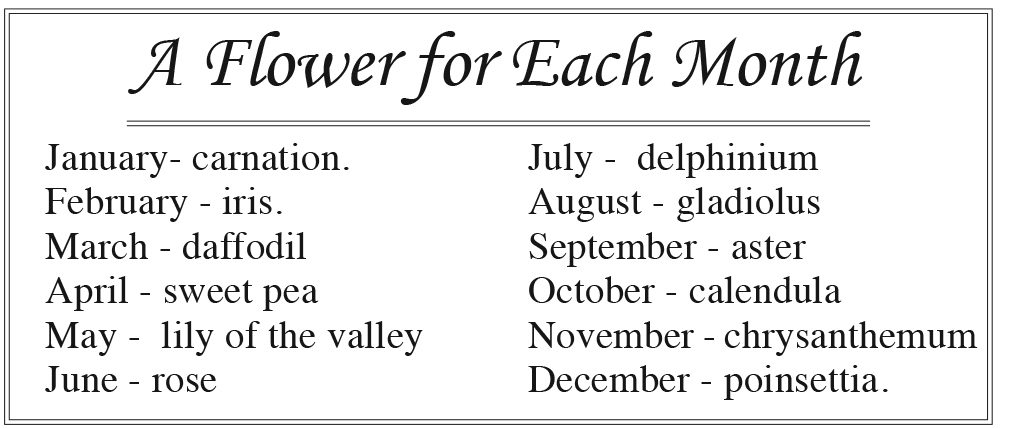The Language of flowers
by Mary Drake –
Color
Probably the most obvious feature of flowers is their color, and what a rainbow of shades there are!
Red typically indicates passion, which is why red roses are so popular on Valentine’s Day when we all declare our love. But other flowers besides roses come in red, such as tulips, carnations, and geraniums.
White typically means purity or innocence, which is why white flowers are traditional at weddings, but they are appropriate any time of the year. The array of white flowers includes daisies, carnations, and of course the beautiful rose.
If your loved one has a sunny disposition, consider yellow flowers. Yellow is associated with the sun, with the happiness and joy we tend to feel when the sun is out. Yellow flowers are a good choice for anyone who spreads positive energy and can be appreciated both by your loved ones as well as by friends. They speak of friendship and appreciation, whether for a job well done in the workplace or in sympathy to a friend who is ill. They are also associated with filial love, which is why they are also appropriate for Mother’s Day. So yellow is an all-around positive color that can be found in sunflowers, daisies, daffodils and chrysanthemums. And don’t forget yellow roses.
Pink is often associated with gentleness and femininity, which is why this color flower is used for Mother’s Day bouquets. It is another versatile any time of the year flower color choice for lovers of pink. Some pink flowers are peonies, carnations, azaleas, and more roses.
Orange flowers make a bold statement and therefore indicate enthusiasm, excitement, and happiness. Marigolds, tulips, and zinnias usually come in eye-catching shades of orange.
Blue is a peaceful color, like the sky on a summer day. Blue flowers are said to make one feel peaceful and help soothe negative emotions. Blue flowers include hydrangeas and delphinium.
Close on the color wheel to blue is purple, but purple flowers come in shades of light and dark. Dark purple flowers like iris, allium (the lovely globe-like flower related to onions), and bellflowers indicate success and are associated with royalty. Light purple flowers, those that are lavender colored, typically indicate grace, elegance and youth. Everyone appreciates purple flowers like lilacs, petunias, or the rare orchid.
Association & Season
Often because of their color or because of the season when they bloom, certain flowers are associated with particular holidays or occasions.
As mentioned earlier, roses, mostly red and pink, are associated with love and are therefore a favorite Valentine flowers. But because they bloom in June, a popular time for weddings, they are also much prized as wedding flowers. Roses are considered a symbol of beauty and were the favorite flower of Venus, the Roman goddess of love.
Lilies, which are most often white, are associated with death and rebirth, which is why they are often seen both at funerals and at Easter.
We usually don’t consider negative emotions when we think of flowers, but the narcissus flower is thought to symbolize selfishness and cold heartedness. This is due to the Greek myth of Narcissus, a beautiful youth who was loved by the nymph Echo, but who rejected her and fell in love with his own reflection in a pool of water. He pined away for himself and was changed into the flower that bears his name. Narcissus flowers are a type of daffodil but with white outer petals and and an orange or yellow trumpet in the center.
Violets, low growing purple flowers, are associated with the virtue of humility, perhaps because they don’t assume to hold up their heads too high.
Iris flowers, which are typically purple, were named after the Greek goddess of the rainbow who acted as a messenger for the gods. Her name “Iris” means “eye of heaven,” since this goddess carried messages from heaven by traveling down to earth on a rainbow. Of course the iris is also the part of the eye which contains pigment and so determines the eyes’ color, So if you love someone’s eyes, consider giving them irises.
Then there is the story of a nymph named Clytie who fell in love with Helios, the Sun god. When he spurned her, it’s said that she sat on a rock all day staring up at her lover, the Sun, turning her head to follow his progress through the sky. So it is also thought (wrongly) that the Sunflower turns its head towards the Sun.
And did you know that there is a flower associated with every month? Check out the box at the bottom to learn more about monthly flowers. The next time you buy flowers for someone’s birthday this might be a consideration.
If that isn’t enough flower lore, recent scientific research also suggests that flower petals have a static electric charge that attracts bees. It’s similar to the static electricity that often makes dry hair stand on end when it’s brushed. In the same way, “the static electric charge on a flower’s petals pulls on the hair on the bumblebee.”* It’s a very subtle electrical charge and each flower species has its own distinct electrical charge that helps identify that flower to the bee. Maybe we, like the bees, are attracted to certain flowers because of their charge.
So, there is much that flowers have to say to us if we understand their language.
*www.pri.org flowers_give_ electrical_signal_bees
